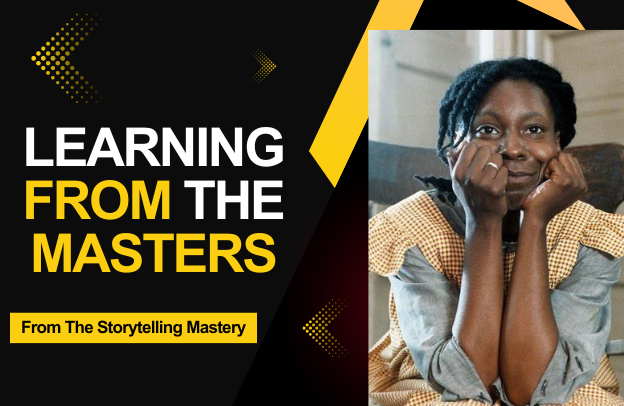The Color Purple: 6 Lessons For Beginner Storytellers – Learning From The Masters

Are you passionate about storytelling? Then welcome to today’s episode of Learning from the masters, a series where we learn from the greatest storytellers out there. Today, we are going to consider The Color Purple and 6 Lessons for Beginner Storytellers. From creating characters that leap off the page, connecting to the right human emotion to weaving simple yet mesmerizing plots, there is a lot to cover about ‘The Color Purple’ as a masterpiece to learn from
Want to learn more? Then start by downloading the first chapter of The Storytelling Mastery.
The film plot – The Color Purple
“The Color Purple” is an emotional drama set in 1982 that revolves around the life of Celie Harris, portrayed by Whoopi Goldberg. Celie endures a life marked by hardship, abuse, and separation from her beloved sister.
The narrative unfolds through Celie’s letters to God, which serve as a therapeutic outlet for her thoughts and emotions. The story takes a transformative turn with the arrival of the glamorous blues singer, Shug Avery (played by Margaret Avery), who becomes a catalyst for Celie’s self-discovery and empowerment.
“Dear God,
I am fourteen years old. …I have always been a good girl. Maybe you can give me a sign letting me know what is happening to me.”
See the full video – The Color Purple: 6 Lessons For Beginner Storytellers – Learning From The Masters
Through their complex relationship, Celie learns to find her voice, assert her identity, and embrace the strength within her.
As Celie’s journey unfolds, the film explores themes of resilience, sisterhood, cultural pride, and the transformative power of love. The narrative weaves through Celie’s connections with other significant characters, including Sofia (portrayed by Oprah Winfrey) and Nettie, Celie’s long-lost sister.
The film paints a vivid portrait of the African American experience during a challenging period, capturing both the struggles and triumphs of its characters as they navigate societal expectations, discrimination, and personal growth.
The Color Purple is a compelling narrative of resilience, love, and the quest for self-empowerment in the face of adversity. Now, here are 6 lessons from the film and how beginner storytellers can replicate the same in their works.
Lesson 1: Embrace Resilience Like Celie:
Learn from Celie’s unwavering strength. Despite facing oppression and hardship, she stands tall. An example from the film is Celie’s enduring spirit while undergoing abuse and separation from her sister.
Application in your stories: As a beginner storyteller, consider infusing your characters with resilience. Show them facing challenges head-on, and let their strength inspire your audience. You could introduce a protagonist overcoming personal struggles, and gradually gaining strength and resilience through challenges.
Lesson 2: Celebrate Sisterhood and Brotherhood:
“The Color Purple” emphasizes the power of connections, especially among women. Nurture strong bonds between your characters. Showcase the beauty of sisterhood and brotherhood within the African diaspora. In the film, you see the deep friendship between Celie and Shug Avery, and the eventual reunion with her sister, Nettie.
Application in your stories: Consider developing strong bonds between characters to emphasize support and unity. You could do this by showcasing a group of friends or family members who navigate challenges together, relying on each other’s strengths.
Lesson 3: Speak Your Truth with Sofia’s Boldness:
Sofia fearlessly speaks her mind, refusing to be silenced. In your stories, let your characters find their voices. Encourage them to speak their truth, mirroring the strength and resilience of African diaspora communities. Example: Sofia standing up against oppression and injustice.
Application in your stories: Give your characters a voice. Let them express their opinions, confront challenges, and stand up for themselves. Consider creating a character who is unafraid to challenge societal norms, speaking out against injustice and discrimination in society.
Lesson 4: Embody Cultural Pride:
The film beautifully captures the essence of African heritage. Infuse your stories with cultural richness. Highlight traditions, languages, and customs that celebrate the diversity within the African diaspora.
The portrayal of African cultural elements in the Olinka village. That in a particular way, made the film more relatable to the African people and people of the African diaspora.
Application in your stories: Consider infusing your stories with elements of African heritage. Explore traditions, languages, and customs that are unique to the characters. You could do this by incorporating scenes that highlight cultural celebrations, rituals, or conversations in native languages to enrich the narrative.
Lesson 5: Navigate Transformation Like Shug Avery:
Shug undergoes a profound transformation, evolving from a glamorous singer to a woman of substance. Let your characters grow and transform.
Show their journey towards self-discovery, mirroring the resilience and self-love found in African diaspora narratives. One great example from the film is Shug’s evolution from a distant figure to a compassionate and nurturing presence in Celie’s life.
Application in your stories: Allow your characters to evolve throughout the story. Show their personal growth, learning, and self-discovery. One good way to do this will be to develop a character who transforms from a hesitant individual to someone confident and self-assured through experiences and self-reflection.
Lesson 6: Champion Love and Redemption:
At its core, “The Color Purple” is a story of love and redemption. In your tales, emphasize the healing power of love and the possibility of redemption.
Showcase characters finding love in unexpected places and the transformative impact it has on their lives. In the film, you see Celie’s journey towards self-love and the redemption of abusive characters.
Application in your stories: Integrate themes of love and redemption into your narratives. Showcase the healing power of love and the possibility of positive change. You could craft a storyline where a character, initially perceived as negative, undergoes redemption through genuine connections and love.
The key to weaving these lessons seamlessly into your storytelling is to use them as guiding principles for character development, plot progression, and thematic exploration.
As you experiment with these elements, your stories will naturally reflect the strength, unity, cultural richness, and transformative power as depicted in “The Color Purple.”
Now, this is the message for you. As you embark on your storytelling journey, remember to embrace the strength, resilience, and cultural richness found in the African diaspora, and let your stories resonate with the hearts of your audience. Keep honing your craft and let your unique voice shine through in every tale you tell.
The importance of storytelling for the African diaspora
For the African diaspora, storytelling serves as a powerful tool for cultural preservation, connection, and empowerment.
Throughout history, oral traditions have been a cornerstone of African cultures, passing down knowledge, values, and experiences from one generation to the next. In the diaspora context, storytelling becomes a means of preserving and transmitting rich cultural heritage that might have been disrupted through forced migrations and historical challenges.
It allows communities to reclaim and celebrate their identity, fostering a sense of continuity and resilience in the face of adversity.
Moreover, storytelling within the African diaspora plays a crucial role in building bridges and fostering unity. By sharing narratives that resonate with shared experiences, struggles, and triumphs, individuals from diverse backgrounds within the diaspora find common ground.
These stories create a sense of collective identity, emphasizing the strength and interconnectedness of the diaspora community. Through storytelling, the African diaspora not only preserves its cultural legacy but also empowers individuals, providing a platform for self-expression, representation, and the celebration of the diversity and richness of their collective experiences.
Conclusion on The Color Purple: 6 Lessons For Beginner Storytellers
In conclusion, storytelling stands as a beacon of strength and unity within the African diaspora, offering a profound means of cultural preservation and empowerment.
Through the art of narrative, individuals within the diaspora weave a tapestry of resilience, love, and shared identity, transcending geographical boundaries and historical challenges.
The stories told serve not only as a testament to the past but also as a guiding light for the future, inspiring generations to come. As the vibrant voices of the African diaspora continue to resonate through storytelling, they carry forth the legacy of a people who, against all odds, have found power and beauty in their shared tales of triumph, forging an enduring connection that transcends time and space.
In the heart of every narrative lies a testament to the strength, unity, and indomitable spirit of the African diaspora, a testament that continues to shape the narrative of a community bound together by the threads of its own extraordinary story.
Want to learn more? Then start by downloading the first chapter of The Storytelling Mastery.






